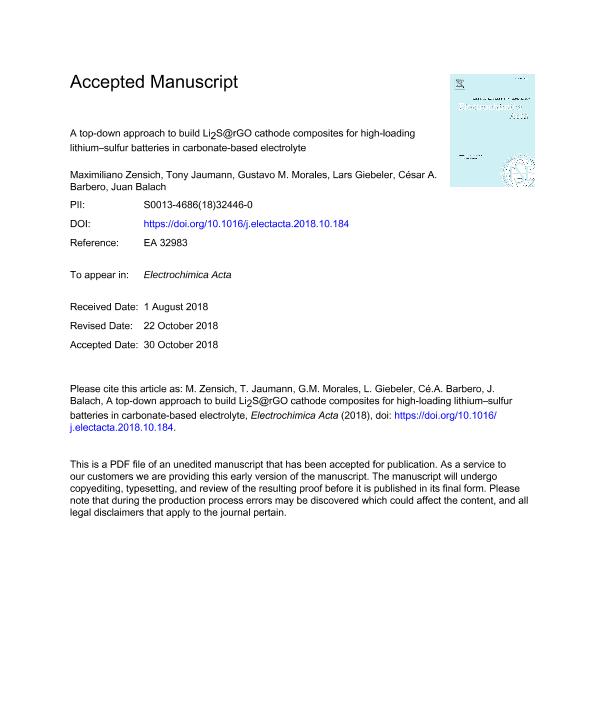Artículo
A top-down approach to build Li2S@rGO cathode composites for high-loading lithium–sulfur batteries in carbonate-based electrolyte
Zensich, Maximiliano Andres ; Jaumann, Tony; Morales, Gustavo Marcelo
; Jaumann, Tony; Morales, Gustavo Marcelo ; Giebeler, Lars; Barbero, César Alfredo
; Giebeler, Lars; Barbero, César Alfredo ; Balach, Juan Manuel
; Balach, Juan Manuel
 ; Jaumann, Tony; Morales, Gustavo Marcelo
; Jaumann, Tony; Morales, Gustavo Marcelo ; Giebeler, Lars; Barbero, César Alfredo
; Giebeler, Lars; Barbero, César Alfredo ; Balach, Juan Manuel
; Balach, Juan Manuel
Fecha de publicación:
02/2019
Editorial:
Pergamon-Elsevier Science Ltd
Revista:
Electrochimica Acta
ISSN:
0013-4686
Idioma:
Inglés
Tipo de recurso:
Artículo publicado
Clasificación temática:
Resumen
With a notable advantage in terms of specific capacity (1166 mAh g−1), lithium disulfide (Li2S) has been considered a promising cathode material for high-energy-density lithium–sulfur (Li–S) batteries. In contrast to pure sulfur, Li2S opens the opportunity to implement alternative anodes such as silicon or graphite instead of hardly controllable lithium metal. However, its intrinsically low conductivity and the formation of soluble lithium polysulfide species during cell operation resulting in a poor cycling stability, especially in carbonate-based electrolytes. Herein, a reduced graphene oxide-wrapped Li2S particles (Li2S@rGO) electrode is presented for improving the electrochemical performance of Li–S batteries in carbonate-based electrolytes. A hydrothermally prepared rGO-covered MoS2 particles composite was fully lithiated and irreversible decomposed at 0.01 V vs. Li/Li+ to in situ produce a Li2S@rGO composite with a high Li2S loading of ≈5 mg cm−2. Despite operating Li–S cells in a conventional carbonate-based electrolyte, the resulting cathode exhibits high initial capacity (975 mAh gLi2S −1 and 1401 mAh gS −1 at 0.1 C), low degradation rate (0.18% per cycle after 200 cycles at 2 C) and excellent Coulombic efficiency (≈99.5%). This work provides a simple strategy to fabricate practical high-loading Li2S cathodes for high-performance Li–S batteries “free” of polysulfide shuttle phenomenon.
Archivos asociados
Licencia
Identificadores
Colecciones
Articulos (IITEMA)
Articulos de INSTITUTO DE INVESTIGACIONES EN TECNOLOGIAS ENERGETICAS Y MATERIALES AVANZADOS
Articulos de INSTITUTO DE INVESTIGACIONES EN TECNOLOGIAS ENERGETICAS Y MATERIALES AVANZADOS
Citación
Zensich, Maximiliano Andres; Jaumann, Tony; Morales, Gustavo Marcelo; Giebeler, Lars; Barbero, César Alfredo; et al.; A top-down approach to build Li2S@rGO cathode composites for high-loading lithium–sulfur batteries in carbonate-based electrolyte; Pergamon-Elsevier Science Ltd; Electrochimica Acta; 296; 2-2019; 243-250
Compartir
Altmétricas



